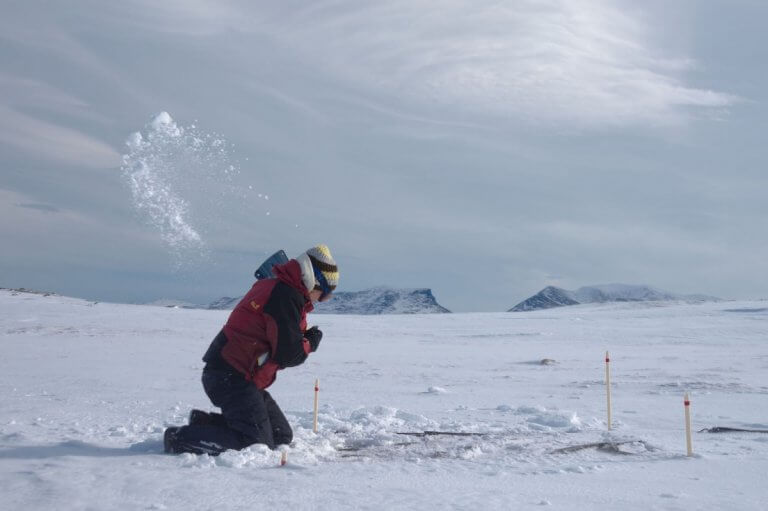
The Arctic is on the frontline of many global issues, and climate change is affecting this region faster than the rest of the globe. With issues of environmental change, contaminants and indigenous peoples, it’s a fascinating and important area for study, not to mention a place of outstanding natural beauty and biodiversity.
The Department of Ecology and Environmental Science at Umea University in Sweden offers unbelievable opportunities to live, study and work in the Arctic Circle.
Its Climate Impacts Research Centre (CIRC) in Abisko Lapland, Northern Sweden, conducts interdisciplinary research from process-level studies to comprehensive landscape-level studies in both aquatic and terrestrial Arctic ecosystems.

Abisko Fieldwork. Photo taken by Ive van Krunkelsven
You have the opportunity get involved with this exciting Arctic research, as CIRC offers a variety of timely and exciting studentships and internships based at the Research Station, 200 km north of the Arctic Circle.
With over 40 scientists at the CIRC studying at the frontline of the Arctic, collating research that forms the basis of all courses, students immerse themselves in Arctic ecosystems while living at the internationally-recognised Abisko Scientific Research Station.
Pursuing exciting ecological and environmental scientific research can take many different forms, as the Centre hosts scientists and visiting students from all over the world, with the busiest period between June and September.
You can study at in the Arctic for your Bachelor’s or Master’s thesis work. The department offers 15-credit courses in the Arctic Ecosystems, Arctic Geoecology Masters and in the Alpine Ecology Bachelor.

Alpine Ecology Geomorphology Fieldtrip 2018. Photo by Yrsa Landström
If you would like to immerse yourself in the landscape you can undertake the ‘Year in the Arctic’ programme which can start any term, but includes all three of the aforementioned masters courses.
Each course provides students with lectures, field excursions, and project work that includes fieldwork, analytical techniques and writing scientific reports.
During the year, you’ll get stuck into data collection from plant-soil-organism interactions, aquatic transport of nutrients, mountain animal species adaptations and local hydrology.
There are also three options for independent coursework in Theoretical Ecology, Earth Science and Environmental Science, where students are paired with scientists from the CIRC to conduct a literature review and meta-analysis of the peer-reviewed texts on Arctic-focused topics. These and other courses are available both in Abisko and in Umeå where you will find a diverse and interesting course offering.
Alternatively, pair up with an Arctic scientist to focus your degree thesis in Biology or Earth Science and develop your own individual project at the research centre.
This summer, Tara Cox lived at the research station, studying the impacts of changing climate on plant-pollinator interaction networks as part of her Master’s thesis and for the project Bumblebee Phenology in the Arctic.

Bumblebee Phenology, Nuolja. Tara Cox, Olivia Bates, Frida Brännlund 2018. Photo by Yrsa Landström
Meanwhile, bachelor student Hannah Rosenzweig is currently leading the Nuolja Plant Phenology Project while working on her thesis about how plant phenology changes under the influence of different environmental factors such as temperature and snow.
“I am very excited to work the second season on the Nuolja Plant Phenology Project to refine my knowledge and increase my understanding of the Arctic ecosystems, to create a team of ambitious fieldworkers and an international setting of shared experience and knowledge between scientists, interns and tourists,” she says.
During your time at the CIRC, besides getting outdoors for your exciting field work and study and meeting scientists from around the world, you’ll be living in a mecca for outdoor activities.
Abisko is the start of the world-famous Kungsleden or King’s Trail (400km from Abisko to Hemavan) and there are vast opportunities for trail running, fishing, ice climbing and rock climbing (in nearby Norway).
Whether you love to go hiking, fishing or backpacking, there will be plenty to enjoy during your spare time.
If your stay falls over autumn or winter, you should bring your own gear to experience unrivalled opportunities for backcountry skiing and snowshoeing. You might even be lucky enough to see northern lights!
Remember – you will be living and working in these remote and wild environments, so be prepared for wind, rain, sun or snow any month of the year!

Fjällekologi Nuolja. Photo by Keith Larson
Torben Windirsch also interned at the centre this summer. “One of the greatest experiences, apart from helicopter flights and cozy camping evenings, was starting a field day in shorts at the station, ending up with several layers in dense snow at the field site.”
The Centre also specialises in communicating research to the scientific community, the public and policy makers to increase awareness about climate and environmental change-related impacts on Arctic environments.
So much so, that the Centre provides a course designed specifically for PhD candidates to help with Communicating Scientific Research, allowing them to present their findings to a wider audience and have their voices heard.
The Climate Impacts Research Centre provides a scientific platform for excellent research, teaching and public outreach in Abisko, serving a key role in Umeå University researchers’ and students’ activities in the Arctic.
Why not choose to study or intern at CIRC and expand your knowledge of this fascinating and fragile arctic ecosystem?
Follow Umeå University on Facebook, Twitter, YouTube and Instagram
Liked this? Then you’ll love…
How to become a global environmental change maker
Umeå University: Advancing Science through 5 strong research environments







